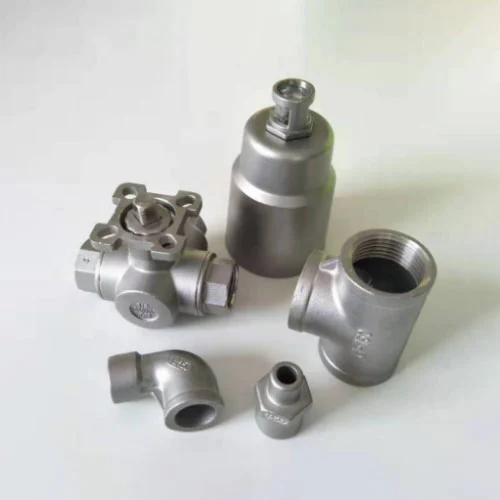Die Casting's Adaptability to Complex Shapes
2025-07-04
Introduction
Die casting is a widely used manufacturing process that involves injecting molten metal under high pressure into a steel mold, known as a die. This method is known for its precision, speed, and high-quality production of metal components. One of the most significant advantages of die casting is its adaptability to complex shapes, which allows it to be applied in a range of industries, from automotive and aerospace to electronics and consumer goods. This essay explores how die casting can accommodate intricate designs, the technological advancements that support this adaptability, and the industries that benefit from it.
The Mechanics of Die Casting
Die casting works by forcing molten metal into a cavity of a mold or die under pressure. The die is typically made of high-grade steel, which can withstand the intense pressure and heat involved in the process. The die casting process is categorized into two main types: cold chamber die casting and hot chamber die casting. Cold chamber die casting is typically used for metals with high melting points, such as aluminum and magnesium, while hot chamber die casting is more suited to metals with lower melting points, like zinc and lead alloys.
Regardless of the type, the key advantage of die casting lies in its ability to produce intricate and complex geometries with high repeatability and precision.
Adaptability to Complex Shapes
Precision and Detail
Die casting is particularly suited for producing parts with fine details, sharp edges, and tight tolerances. The high-pressure injection of molten metal fills every corner of the die, enabling the creation of parts with fine features such as intricate webbing, thin walls, and small cavities. This level of detail is often difficult to achieve with other traditional metalworking processes such as machining or sand casting.
Design Flexibility
The versatility of die casting allows for the creation of parts with complex shapes, including undercuts, ribs, bosses, and intricate contours. This is made possible by the multi-part dies that can include movable cores or slides, which are inserted into the die to form internal features or complex geometries. For example, parts such as engine blocks, gear housings, or electronic enclosures can be cast with multiple internal channels or cavities without requiring additional assembly.
Thin Walls and Lightweight Components
Another key benefit of die casting’s adaptability is its ability to produce lightweight components with thin walls. The precision of the casting process ensures that thin-walled parts can be made without compromising structural integrity. This is particularly important in industries such as aerospace and automotive, where reducing weight while maintaining strength is crucial for performance and efficiency.
Incorporation of Multiple Features
Die casting can integrate multiple features into a single part, such as threading, grooves, or interlocking mechanisms. This eliminates the need for secondary operations like machining or assembly. For example, a die-cast part for the automotive industry may incorporate not just the structural shape, but also pre-drilled holes, threaded inserts, and other functional features directly into the component, making the manufacturing process more efficient and cost-effective.

Technological Advancements in Die Casting
Modern die casting technology has advanced significantly, further enhancing its ability to accommodate complex shapes. These advancements include:
3D Printing and CAD Integration
The integration of 3D printing and advanced computer-aided design (CAD) software has revolutionized die casting by allowing engineers to design more intricate and optimized parts. With CAD, engineers can simulate how molten metal will behave inside the mold, allowing them to refine the design for better efficiency and manufacturability. 3D printing is also used to produce prototype dies quickly, making the development of complex parts faster and less expensive.
Advanced Die Materials
The development of advanced die materials, such as high-strength steel alloys and coatings, has also expanded the adaptability of die casting. These materials are more resistant to wear, heat, and pressure, allowing for longer production runs and more complex mold designs without the risk of die failure. This extends the life of the die and improves the overall efficiency of the process.
Multi-Cavity Dies
Multi-cavity dies, which allow the simultaneous casting of multiple parts in a single cycle, are another advancement that contributes to die casting’s ability to handle complex shapes. By reducing cycle time and improving overall production efficiency, these dies allow manufacturers to produce intricate designs on a large scale without sacrificing quality.
Vacuum Die Casting
Vacuum die casting is a relatively recent innovation that helps prevent air pockets or voids in the casting, which can compromise the strength and integrity of the final product. This technology is particularly useful for producing high-precision parts that require excellent material properties, such as those found in the aerospace or medical device industries.
Applications of Die Casting in Complex Shapes
Automotive Industry
The automotive industry is one of the primary beneficiaries of die casting’s ability to produce complex shapes. Engine components, transmission housings, and structural parts are often made using die casting. The need for lightweight yet durable parts in modern vehicles, especially with the rise of electric vehicles (EVs), has spurred greater demand for die-cast components with complex geometries. The process allows automakers to create parts that reduce weight and improve fuel efficiency while maintaining strength and safety.
Aerospace
In aerospace, die casting is used to produce high-precision components for aircraft engines, fuselages, and landing gear. The ability to cast thin-walled, high-strength components that can withstand extreme stress and temperatures is crucial in this industry. Die-cast parts help reduce the overall weight of the aircraft, contributing to fuel efficiency and performance.
Electronics
The electronics industry also benefits from die casting’s ability to produce intricate enclosures and components for devices such as smartphones, laptops, and telecommunications equipment. These components need to be both lightweight and durable, with precise features like screw threads and mounting points. Die casting offers a cost-effective solution to meet these requirements.
Consumer Goods
Many consumer products, including kitchen appliances, power tools, and decorative items, are manufactured using die casting. The process allows for the creation of parts with detailed designs, such as intricate patterns or textured surfaces, which are often required in high-end consumer products.
Conclusion
Die casting’s ability to produce parts with complex shapes is one of its most significant advantages. Through technological advancements such as 3D printing, advanced die materials, and vacuum die casting, the process has become more adaptable to intricate designs and more efficient at producing high-precision components. Industries ranging from automotive and aerospace to electronics and consumer goods continue to benefit from the cost-effective and versatile nature of die casting, solidifying its position as a key manufacturing process for complex metal parts. As technology continues to evolve, die casting’s capacity for producing ever-more intricate and functional shapes is expected to expand, further cementing its role in modern manufacturing.
As a professional manufacturer and supplier, we provide high-quality products. If you are interested in our products or have any questions, please feel free to contact us.


